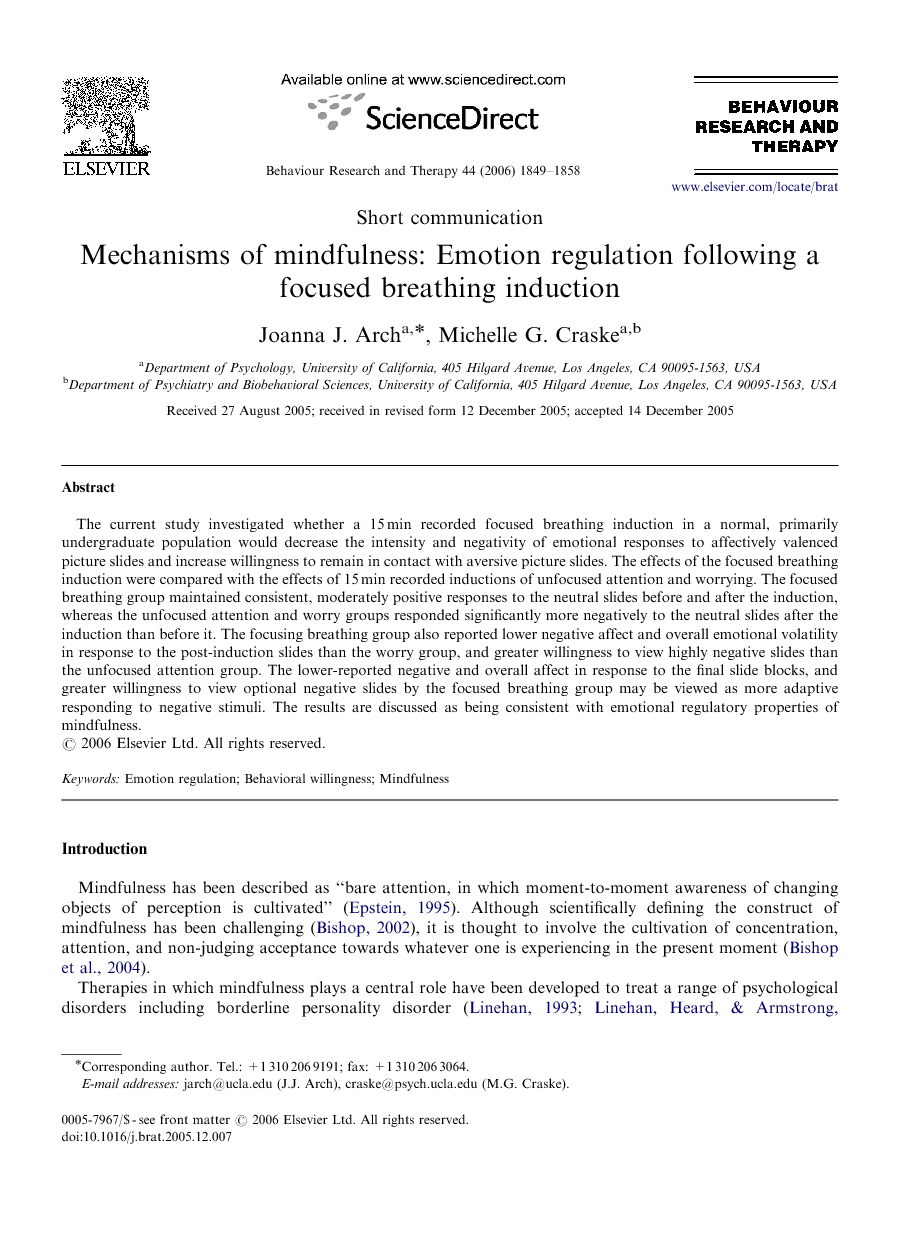The current study investigated whether a 15 min recorded focused breathing induction in a normal, primarily undergraduate population would decrease the intensity and negativity of emotional responses to affectively valenced picture slides and increase willingness to remain in contact with aversive picture slides. The effects of the focused breathing induction were compared with the effects of 15 min recorded inductions of unfocused attention and worrying. The focused breathing group maintained consistent, moderately positive responses to the neutral slides before and after the induction, whereas the unfocused attention and worry groups responded significantly more negatively to the neutral slides after the induction than before it. The focusing breathing group also reported lower negative affect and overall emotional volatility in response to the post-induction slides than the worry group, and greater willingness to view highly negative slides than the unfocused attention group. The lower-reported negative and overall affect in response to the final slide blocks, and greater willingness to view optional negative slides by the focused breathing group may be viewed as more adaptive responding to negative stimuli. The results are discussed as being consistent with emotional regulatory properties of mindfulness.
Mindfulness has been described as “bare attention, in which moment-to-moment awareness of changing objects of perception is cultivated” (Epstein, 1995). Although scientifically defining the construct of mindfulness has been challenging (Bishop, 2002), it is thought to involve the cultivation of concentration, attention, and non-judging acceptance towards whatever one is experiencing in the present moment (Bishop et al., 2004).
Therapies in which mindfulness plays a central role have been developed to treat a range of psychological disorders including borderline personality disorder (Linehan, 1993; Linehan, Heard, & Armstrong, 1993), recurrent depression (Ma & Teasdale, 2004; Segal, Williams, & Teasdale, 2002), and anxiety disorders (Kabat-Zinn et al., 1992; Miller, Fletcher, & Kabat-Zinn, 1995). Several studies also demonstrate the benefits of mindfulness-based practice in non-clinical samples. Results indicate lower levels of intensity and frequency of unpleasant affect for high trait-mindful individuals (Brown & Ryan, 2003) and reductions in state and trait anxiety and psychological distress for individuals participating in an 8-week mindfulness-based intervention, compared with a waitlist control group (Shapiro, Schwartz, & Bonner, 1998).
It has been hypothesized that mindfulness increases willingness to tolerate uncomfortable emotions and sensations (Eifert & Heffner, 2003; Levitt, Brown, Orsillo, & Barlow, 2004) and emotional acceptance (Hayes, Strosahl, & Wilson, 1999; Linehan, 1993; Segal et al., 2002), and decreases the impact and time needed to recover from negative emotional events (Kabat-Zinn, 1990), among others. Nevertheless, few studies have directly tested these proposed mechanisms of action (for a qualitative-based exception, see Mason & Hargreaves, 2001).
The current study investigates the immediate effects of a 15-min experiential “induction” of focused breathing using ongoing mindfulness of breath instructions. The induction is called “focused breathing” rather than “mindfulness” due to the fact that participants had no previous training in mindfulness and a true induction of mindfulness would likely require extensive training in mindfulness. Thus, the current study is an analogue of mindfulness, modeling the effects of first-time instruction. The effects of the focused breathing exercise were compared to the effects of unfocused attention and worrying. Instructing participants to “let their minds wander” through unfocused attention or to deliberately worry, provided appropriate contrasts to the deliberate letting go of intrusive thoughts and present-focused instructions for focused breathing. We hypothesized that a 15 min focused breathing induction in a normal, primarily undergraduate population would decrease the intensity and negativity of emotional responses to affectively valenced external stimuli and increase willingness to remain in contact with aversive external stimuli.


